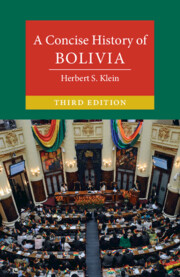Book contents
- A Concise History of Bolivia, Third Edition
- Cambridge Concise Histories
- A Concise History of Bolivia Third Edition
- Copyright page
- Contents
- Preface to the Third Edition
- Preface to the Second Edition
- Preface to the First Edition
- Chapter 1 Geography and Pre-Columbian Civilization
- Chapter 2 The Creation of a Colonial Society
- Chapter 3 Late Colonial Society: Crisis and Growth
- Chapter 4 Revolution and the Creation of a Nation-State, 1809–1841
- Chapter 5 The Crisis of the State, 1841–1880
- Chapter 6 The Ages of Silver and Tin, 1880–1932
- Chapter 7 Disintegration of the Established Order, 1932–1952
- Chapter 8 From the National Revolution to the Cold War, 1952–1982
- Chapter 9 Creating a Multiethnic Democracy, 1982–2002
- Chapter 10 The Emergence of a Mestizo and Indigenous Elite
- Political Chronology
- Tables
- Bibliography
- Index
Chapter 10 - The Emergence of a Mestizo and Indigenous Elite
Published online by Cambridge University Press: 02 December 2021
- A Concise History of Bolivia, Third Edition
- Cambridge Concise Histories
- A Concise History of Bolivia Third Edition
- Copyright page
- Contents
- Preface to the Third Edition
- Preface to the Second Edition
- Preface to the First Edition
- Chapter 1 Geography and Pre-Columbian Civilization
- Chapter 2 The Creation of a Colonial Society
- Chapter 3 Late Colonial Society: Crisis and Growth
- Chapter 4 Revolution and the Creation of a Nation-State, 1809–1841
- Chapter 5 The Crisis of the State, 1841–1880
- Chapter 6 The Ages of Silver and Tin, 1880–1932
- Chapter 7 Disintegration of the Established Order, 1932–1952
- Chapter 8 From the National Revolution to the Cold War, 1952–1982
- Chapter 9 Creating a Multiethnic Democracy, 1982–2002
- Chapter 10 The Emergence of a Mestizo and Indigenous Elite
- Political Chronology
- Tables
- Bibliography
- Index
Summary
The shock of the election of 2002 followed by the massive, violent, and ever more effective blockades by mestizos and indigenous groups created the backdrop for the emergence of the first coherent and powerful mass political party led by mestizo and indigenous leaders. By the time of the presidential election of December 2005, most of the traditional parties had been replaced by a new non-indigenous party known as Podemos, while Morales and his MAS party emerged as the single most important party in the country. In December 2005, the MAS and the MIP, the other indigenous party, received 1.6 million votes of the 2.9 million cast, or 56 percent of the total. Thus in just three short years all the traditional parties lost their importance. Of the new groups to emerge in this period, the most important was the MAS, led by Evo Morales, which finally came to power in the presidential election of 2005 and would remain the nation’s most powerful party for the next fifteen years. Moreover, although mestizos had been presidents of Bolivia, the most famous being Andrés de Santa Cruz y Calahumana, this was the first time in republican history that a president was elected who defined himself as an indigenous person.
- Type
- Chapter
- Information
- A Concise History of Bolivia , pp. 264 - 308Publisher: Cambridge University PressPrint publication year: 2021

